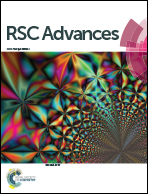Preparation of PVDF/FMBO composite electrospun nanofiber for effective arsenate removal from water
Abstract
In this study, novel electrospun nanofibers (NFs) composed of organic polyvinylidine fluoride (PVDF) and inorganic Fe–Mn binary oxide (FMBO) nanoparticles were fabricated using an electrospinning technique for adsorptive decontamination of As(V) from polluted water. The NFs were prepared with doped solutions consisting of different weight ratios of PVDF/FMBO, in a NF matrix, ranging from 0 to 0.5. SEM, XRD, FTIR and TEM then characterized the NFs and FMBO particles. The XRD analysis indicated successful impregnation of FMBO nanoparticles in the NF matrix of the NFs investigated. An As(V) adsorption capacity as high as around 21.32 mg g−1 was obtained using the NF containing the highest amount of FMBO nanoparticles (designated as PVDF/FMBO 0.5). Furthermore, the adsorptive performance of the PVDF/FMBO 0.5 nanofiber could be easily regenerated using diluted alkaline solution (NaOH and NaOCl).



 Please wait while we load your content...
Please wait while we load your content...